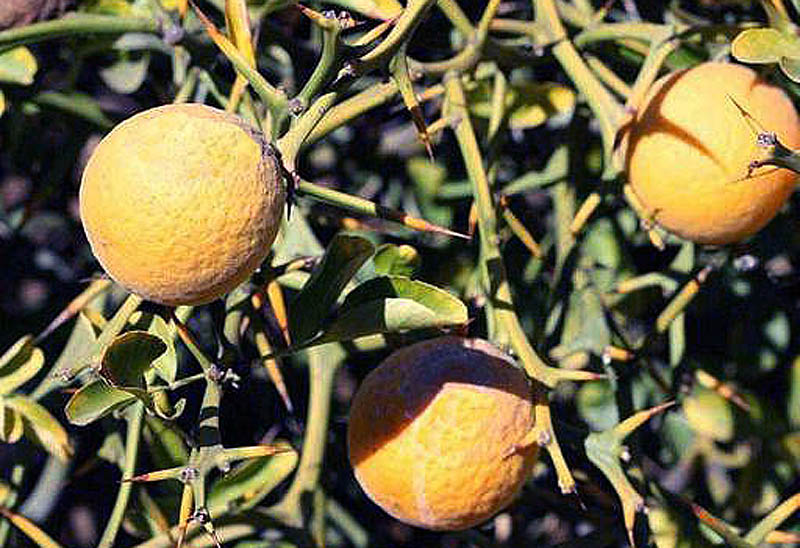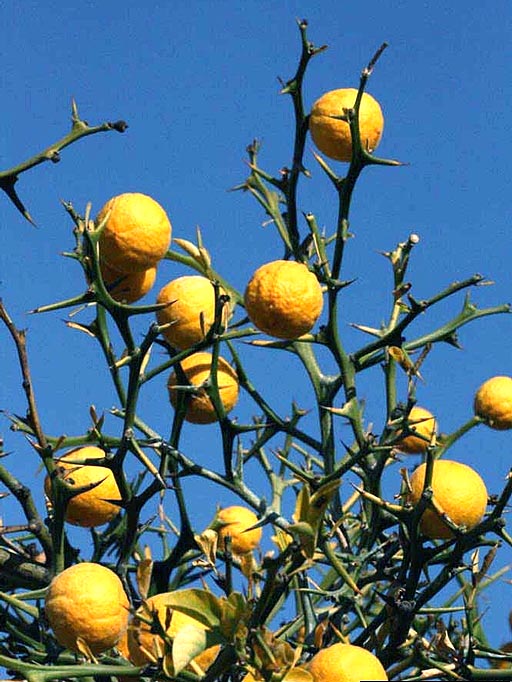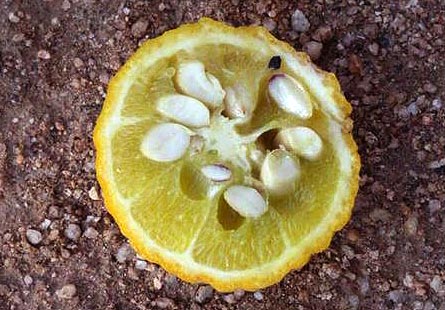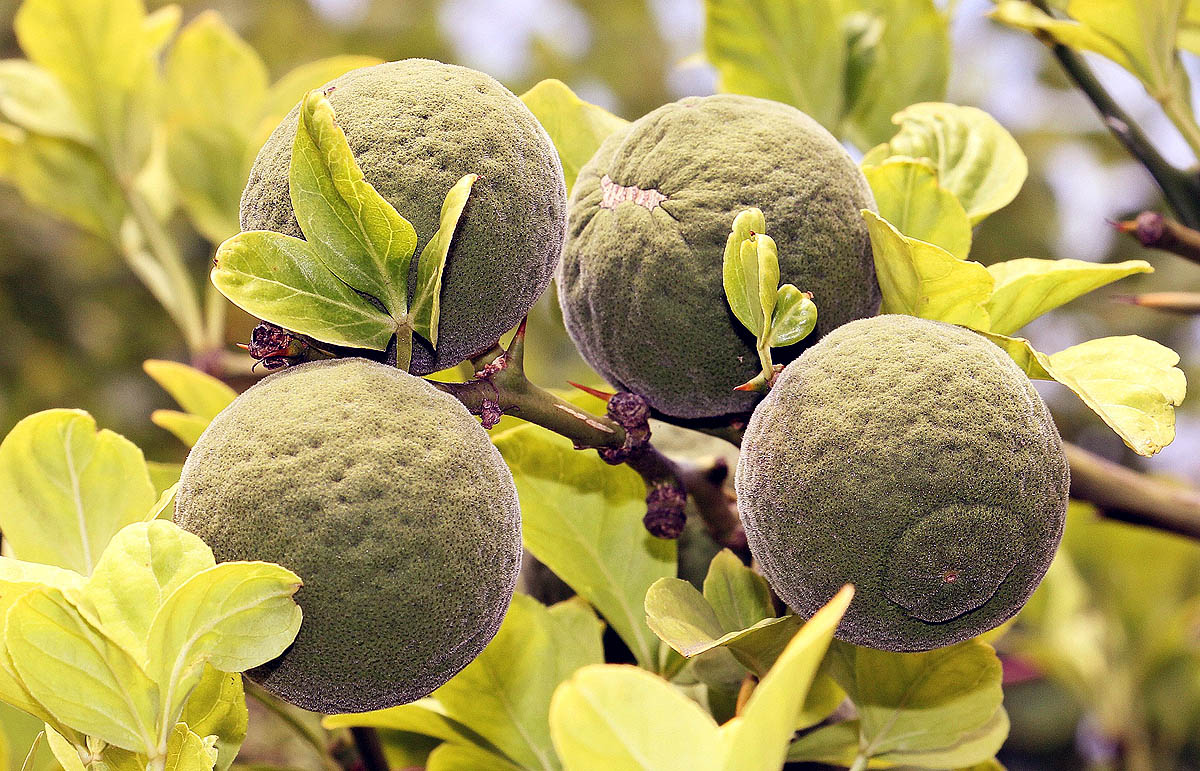A lovely small tree that produces bitter citrus fruit up to zone 6, although some suggest 5 with protection. A very thorny tree with contorted twisted branches giving one of its common names of flying dragon. Produces masses of lovely white flowers in early to mid spring that are followed by bright orange citrus fruits which are very aromatic and give the tree an attractive interest. The fruits are bitter but can be used in making marmalade and the juice can be used like lemons. The fruits are also strongly medicinal. Very easy to grow from seed makes an attractive small tree, and takes well to being potted. It can also be grown as a protective hedge as nothing will get through the vicious thorns it produces. However wildlife love it. Pollinators and butterflies flock to the flowers the its a major host Giant Swallowtail butterfly caterpillars and birds love to build their nests in it as is provides so much protection from predators.
Needs full sun in cooler zones some shade in warmer ones and takes little care once established although a little pruning can make it look more attractive.
The leaves are quite different from most citrus species being compound consisting of three lobes - hence its name trifoliate. Leaflets are mostly oval with wavy edges and from 1-2 inches (2.5-5 cm) long they are waxy, stiff and occur in far less numbers than most trees produce.
In early to mid spring the flowers appear in large numbers on old wood, making this an extremely attractive ornamental. Flowers are up to 2 inches (5 cm) in diameter which is larger than most citrus species but they are not as fragrant. Flowers are followed by globe shaped fruits orange from1.25 -2 inches (3-5 cm) in diameter. They begin green and turn bright orange and are very fragrant. These usually occur in larger numbers making the tree stand out and very attractive. The fruits are very tart and not edible raw unless the juice is extracted and diluted. Fruits also contain large numbers of seeds so preparation is required before eating. The plant is self fertile so only one is required to produce fruits.
Growing Bitter orange or Flying Dragon (Poncirus trifoliata) from Seed.
Seeds need a period of at least 30 cold before they will germinate. All our seeds are kept cold before they are shipped to you, we recommend placing seeds directly in the refrigerator on arrival until ready to plant. Sow seeds in individual pots in warm soils in late winter or early spring allow seedlings to grow and flourish repotting to larger pots for the first year of life, Plant out in spring of the second year after danger of frost has passed to give trees plenty of time to acclimatize to their new home.
Its not too picky about soil type or pH that is not really acidic. It will grow in almost any kind provided it does not stay water logged. Prefers light soils with some organic material for best growth, fruit and flowers However regular water is necessary if flowers and useable fruits are desired. A small amount of water twice a week maybe from a soaker hose around the base would be ideal during flower and fruiting season. This will ensure good growth of fruits grow well. If rainfall is sufficient then no water is required. Do not overwater or fruits may split. If fruit collection is not required then plants can be left alone they are fairly drought tolerant and would only require a little water in prolonged drought.
Trees are fairly slow growing so mulching around the base of the plants or use of a weed blanket may be desirable to help ensure that trees are not overrun before they become established, even then keeping are under the plants clear is desirable as weeding under these trees is difficult and unpleasant.
If growing and a protective hedge less pruning may be required. While good airflow is still recommended for healthy plants density may be more desirable. In this case leaving trees alone or just cutting into a shaped hedge may be the best option.
Pollinator and Wildlife with Bitter orange or Flying Dragon (Poncirus trifoliata).
The flowers of this tree are very popular with bees, butterflies and other pollinators. Since it blooms early in the year it is a great early source of nectar. It is also the larval host plant for the Giant Swallowtail butterfly, so if you see caterpillars on your plant, don't throw them off! Although you may need to protect very young trees so they don't get eaten to death before they are large enough to support these beautiful insects.
Once collected its best to store the fruits in the refrigerator for at least two weeks as this will increase the juice yield. Fresh fruits produce only small amounts.
Culinary Uses of Bitter orange or Flying Dragon (Poncirus trifoliata).
The juice is very rich in vitamin C but is very bitter. It can be used fresh in a similar way to lemons although some people like to dilute it first. It can be used to make very refreshing drinks, added to cocktails or flavor ice cream. A good addition to lemon style salad dressings. Fruits contain a large number of seeds so processing them is time consuming. However they are commonly used to make English style marmalade which is far more bitter than the sweet American style. The peal can also be dried and used as a flavoring or to make herbal teas and liqueurs as well as a condiment.
the twisted nature of the branches and slow growth make it idea for bonsai.











